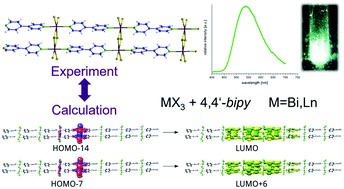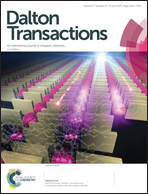Bismuth as a versatile cation for luminescence in coordination polymers from BiX3/4,4′-bipy: understanding of photophysics by quantum chemical calculations and structural parallels to lanthanides†
Abstract
Coordination polymers (CPs) with bismuth(III) as a connectivity centre have been prepared from BiX3 (X = Cl–I) and 4,4′-bipyridine (bipy) in order to implement Bi-based luminescence. The products were obtained via different synthetic routes such as solution chemistry, melt syntheses or mechanochemical reactions. Five neutral and anionic 1D-CPs are presented that show a chemical parallel to trivalent lanthanides forming isostructural or closely related 1D-CPs, of which five additional compounds are described. Bi3+ proves to be a versatile cation for luminescence resulting from energy transfer processes between a metal and a ligand in the presented CPs. Quantum chemical calculations were carried out to investigate Bi3+-participation in the luminescence processes. The calculated results allow an assignment of the bright transitions composed of mainly metal-to-ligand-charge transfer (MLCT) character. These results show that Bi3+ can form strongly luminescent coordination compounds with N-donor ligands.



 Please wait while we load your content...
Please wait while we load your content...